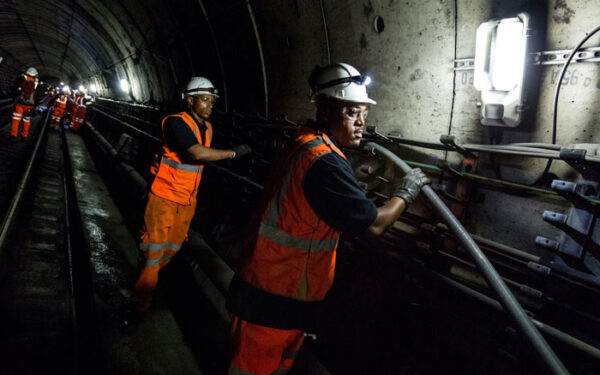People travelling along part of the Jubilee line will soon be able to use their mobile phones while still in the tunnels.
When it goes live, smartphones will be able to connect to Wi-Fi services in the platforms, and switch to cellular coverage when passing through the tunnels. The mobile coverage will also be available in the stations, as a backup for the Wi-Fi, or for people who don’t have access to the Wi-Fi through their phone account.
Equipment supporting mobile phone coverage is currently being added to the tunnels between Westminster and Canning Town and is expected to switch-on next March. The service will also support all three main phone technologies, GSM, 3G and 4G, with 5G to be added later.
The bit some will hate is that it will support voice calls as well as mobile data services, although realistically saying “I’m on the train” isn’t going to be easy in a noisy tube train as it roars through the tunnels.
The first phase that goes live next March will be a trial of the service, and TfL is planning to issue a contract shortly afterwards to expand the service to the rest of the network, with the aim of having the whole tube tunnel network covered by the mid-2020s.
Providing phone coverage underground has been a very long time coming, with many rumours and false-starts over the years. A trial using Huawei hardware and 4G services provided by O2 and Vodafone in the Waterloo and City line in 2017 proved that the technology could be deployed into London’s rather more complicated tunnels infrastructure.
The trigger for the project to go ahead though was thanks to the need to upgrade the existing radio communications network to support the Home Office’s new Emergency Services Network, and when you’re doing that sort of work, adding mobile phone coverage is a modest additional outlay.
Both the emergency services and the mobile phone signals will be delivered into the tunnels along long cables known as leaky feeders, essentially a coaxial cable that has small sections of its copper shielding stripped away to allow radio frequency (RF) signals to escape.
However, it’s not as simple as simply running a long cable along the tunnels. Sometimes multiple cables have to be used due to the different frequencies being deployed for the various phone technologies and networks. It’s not just a bundle of cables though, as the arrangement of the cables in the bundle will affect the way the radio signal leaks out into the tunnels.
Leaky feeder cables also tend to be quite bulky and the cable is rather inflexible as a result, making installation in the tunnels a challenge.
Once installed though, not only do unexpected localised inference issues arise, as while the clay surrounding the tunnels generally absorbs the signals, the tunnel walls and impurities in the surrounding clay can cause unexpected partial refractions in the signal and cause interference to build up.
Add in the trains themselves, with their high electrical currents, electrical motors and sensitive electronics, and the environment for a reliable phone network in the tunnels isn’t a pleasant one.
The trial will help iron out problems that are essentially impossible to test for in a laboratory situation.
By installing cabling within tunnels and stations in advance of awarding the concession to the long term provider, TfL said that it can better manage station access, reduce the amount of disruption these works may cause to customers and allow the concessionaire to then quickly utilise infrastructure once the final contract is awarded. TfL has also begun discussions with mobile network operators to ensure they can access the infrastructure for the pilot.
Once fully delivered, more than 2,000 kilometres of cabling are expected to have been installed within tunnels and stations, all of which will need to be fitted outside of operational hours.
TfL should then be able to recover its costs by renting the capacity to the mobile networks, as happens in most other underground railways that offer phone coverage. How each mobile network operator then decides to offer the service to their customers will be a matter for them to decide later.
Some will doubtless bemoan the arrival of phone coverage on the tube, but as many trains are quite noisy, the chances of making a voice call are slim, and even above ground, most people seem to use phones to read stuff than to talk with.










Looks like those men from Sunderland “where they breed them big ” who appeared in recent £15 billion railway series installing cables will have a busy time …. pull….pull
…pull
As for the eastern end of Jubilee Line the noise of the trains is incredibly I reckon one of the noisiest sections of the tube !
The last refuge from “yeah, it’s me, i’m on the train” brigade
Will be breached………
Well you wanted it !!!